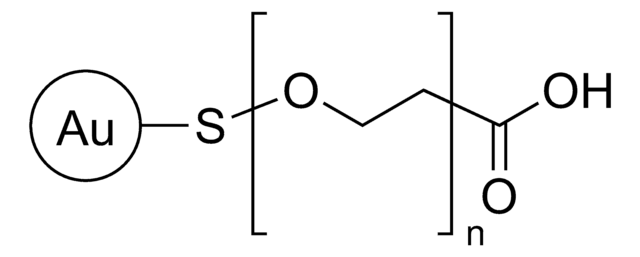추천 제품
일반 설명
Gold nanoparticles (AuNPs) ranging from 2-200nm in diameter find applications in diverse fields. They show excellent biocompatibility and attractive physicochemical properties. Poly (ethylene) glycol (PEG) surface coatings on gold nanoparticles help in the reduction of protein adsorption, reduce nonspecific interactions with cells and greatly improve the pharmokinetics of these nanoparticles and reduce aggregation of the nanoparticles. PEG layer density depends inversely on the AuNP curvature. Denser coating was possible on smaller AuNPs. AuNPs coated with PEG 5000 exhibited highest colloidal stability. Amine functionalized GNPs which have Poly Ethylene Glycol (PEG) as the ligand or carrier molecule forms a conjugate with siRNA and is extremely useful in RNAi technology. Since it adheres to cell membranes, it may find use in cellular and intracellular targeting in targeted drug delivery applications and also used in biodistribution studies.††††
애플리케이션
Functionalized particles have been extensively used to study cellular uptake of nanoparticles and targeted drug delivery.
Used in carrying siRNA which acts against human prostate carcinoma cells by inhibiting a specific cancer gene.
특징 및 장점
- A negatively charged siRNA-PEG complex, attached to positively charged GNPs, is easily cleavable in reductive cytosolic environment thus enabling the release of siRNA into cytosol.
- The PEG coating, decreases the cytotoxicity and increases efficiency of GNPs. PEG increases the stability of the nanoparticles and prevents agglomeration.
Storage Class Code
10 - Combustible liquids
WGK
WGK 2
Flash Point (°F)
Not applicable
Flash Point (°C)
Not applicable
Sinem Diken Gür et al.
Materials science & engineering. C, Materials for biological applications, 104, 109869-109869 (2019-09-11)
The aim of the present study was developing a surface plasmon resonance (SPR) nanosensor to detect Escherichia coli (E. coli) for the diagnosis of urinary tract infections by using surface imprinted Au nanoparticles (AuNPs) as a recognition element. In order
Gold nanoparticles for the improved anticancer drug delivery of the active component of oxaliplatin.
Sarah D Brown et al.
Journal of the American Chemical Society, 132(13), 4678-4684 (2010-03-17)
The platinum-based anticancer drugs cisplatin, carboplatin, and oxaliplatin are an important component of chemotherapy but are limited by severe dose-limiting side effects and the ability of tumors to develop resistance rapidly. These drugs can be improved through the use of
Scott H Brewer et al.
Langmuir : the ACS journal of surfaces and colloids, 21(20), 9303-9307 (2005-09-21)
The interaction of bovine serum albumin (BSA) with gold colloids and surfaces was studied using zeta-potential and quartz crystal microbalance (QCM) measurements, respectively, to determine the surface charge and coverage. The combination of these two measurements suggests that BSA binding
Xiao-Dong Zhang et al.
International journal of nanomedicine, 6, 2071-2081 (2011-10-07)
Gold nanoparticle toxicity research is currently leading towards the in vivo experiment. Most toxicology data show that the surface chemistry and physical dimensions of gold nanoparticles play an important role in toxicity. Here, we present the in vivo toxicity of
Timothy A Larson et al.
ACS nano, 6(10), 9182-9190 (2012-09-27)
Polyethylene glycol (PEG) surface coatings are widely used to render stealth properties to nanoparticles in biological applications. There is abundant literature on the benefits of PEG coatings and their ability to reduce protein adsorption, to diminish nonspecific interactions with cells
문서
The recent emergence of a number of highly functional nanomaterials has enabled new approaches to the understanding, diagnosis, and treatment of cancer.
Biomaterials science involves the design and fabrication of smart materials for studying, directing, or mimicking biology. For successful integration of biomaterials in biological research, a meaningful understanding of biological systems is required.
자사의 과학자팀은 생명 과학, 재료 과학, 화학 합성, 크로마토그래피, 분석 및 기타 많은 영역을 포함한 모든 과학 분야에 경험이 있습니다..
고객지원팀으로 연락바랍니다.


